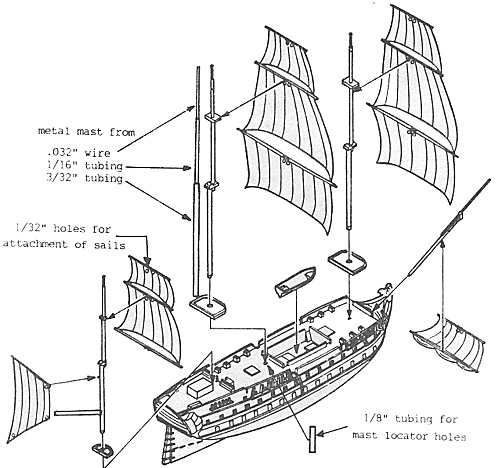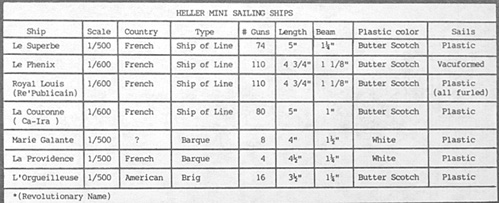 Once or twice a year our gaming group looks for a change of pace by having a Napoleonic naval game. The infrequency of our efforts in this area makes for some difficulty with current rule systems. They are just to detailed to comprehend when not used on a regular basis, thus work was begun on a easy sail-easy fire type of game. To go with these rules we wanted some sailing ships that were larger and more detailed than the current metal models that are on the market. The other day I came across a line of 1/500 and 1/600 scale mini sailing ships (plastic) put out by Heller. These are mini versions of the very detailed line that you see quite often in better hobby shops.
Once or twice a year our gaming group looks for a change of pace by having a Napoleonic naval game. The infrequency of our efforts in this area makes for some difficulty with current rule systems. They are just to detailed to comprehend when not used on a regular basis, thus work was begun on a easy sail-easy fire type of game. To go with these rules we wanted some sailing ships that were larger and more detailed than the current metal models that are on the market. The other day I came across a line of 1/500 and 1/600 scale mini sailing ships (plastic) put out by Heller. These are mini versions of the very detailed line that you see quite often in better hobby shops.
They are ideal for conversion to waterline models and are fairly simple to make.
To start the conversion glue the two halfs of the hull together along with the deck. If there is a stern section to the model this should be attached at this time. The next step is to cut the full hull down to the water line. This can be done by drilling small holes in the bottom of the hull to allow enough room to get a dyke cutter in. The bottom section was ruffed out by cutting small pieces from the hull.
The exact waterline level can be determined by looking at the box cover which shows each ship under sail. After ruffing out the hull sand the bottom level to the waterline using a medium grade sandpaper. Be careful not to sand to fast as the plastic has a low melting point. The ship can now be placed on a level surface and should appear at right "depth" for being in water. To give the hull some weight it can be turned over and filled with plaster of paris. When this has fully dried the bottom will have to be sanded again to provide for a flat smooth bottom. With this weight in the hull the ship will be very stable and it is not necessary to mount on any type of base. When the plaster of paris is put in the hull some might seep through the deck area. This can easily be scraped off using a small screwdriver.
The next item was to start mounting the sails. My own preference was that the sails be removable as it would be much easier to keep track of sail hits if they could be taken off each time they happened. The plastic masts that come with the kits concerned me from a durability standpoint, if they were to be removed during games. (this would not be a problem if one wants to mount them permanently and rig the ship.) For durability I elected to make new masts out of brass tubing and wire. Most hobby shops carry a complete line of of different size tubing. Glue together (5 minute epoxy) per diagram, making sure that mast are the same height as the orginals, plus 2" (section that will go in the hull). Fighting tops can be drilled out and glued to mast at same location they would fit on orginal masts.
With new metal masts made the next step is to make location "holes" for the masts in the deck. Use 1/8" tubing 2" long and drill 1/8" holes in the deck were the masts are located. Holes should be '2" deep. Locater tubes can then be glued into place making sure they are straight up and down. To mount the sails to the masts drill 1/32" holes in the location marked on the diagram, then use very light gauge wire twisted around the masts after which epoxy glue is applied. Sails can then be inserted and modifications would be complete.
For painting tips check The Courier Vol. VI., No.5 for an article "On The Decoration Of Ships" by Jon Williams. This excellent article will give you some good ideas for color schemes for your ships. To obtain the Heller kits you probably have to order through your local hobby shop as they usually don't stock them. It takes 4-6 weeks for them to arrive. Best thing about the kits is the price, for at $2.25 they are very affordable.
As my ship project wasn't being done with a high priority, I decided to order the entire line, work on them when I had time, and not have to worry about them being discontinued in the future. Some of of the kits come in 1/500 scale, while others are in 1/600. They all seem to mix together quite well. Some come with guns molded into the deck while others have the guns seperate and must be mounted. Sails vary from injected plastic to vacuformed type. All in all the kits are quite detailed for their size.
The one drawback I can see in the line is the lack of British ships as most are French. I've been told that Airfix use to have a line of mini ships in a scale similar to these. If anyone has knowledge of these or some other line, I would appreciate if they would contact me. It would be fairly easy to modify some of the available ships to British versions. Another possibility would be to scratch build several British ships and make lead molds for them.
Listed below is a chart of the different kits available, sail data, size data etc.

Back to MWAN # 25 Table of Contents
Back to MWAN List of Issues
Back to MagWeb Magazine List
© Copyright 1987 Hal Thinglum
This article appears in MagWeb.com (Magazine Web) on the Internet World Wide Web.
Other articles from military history and related magazines are available at http://www.magweb.com